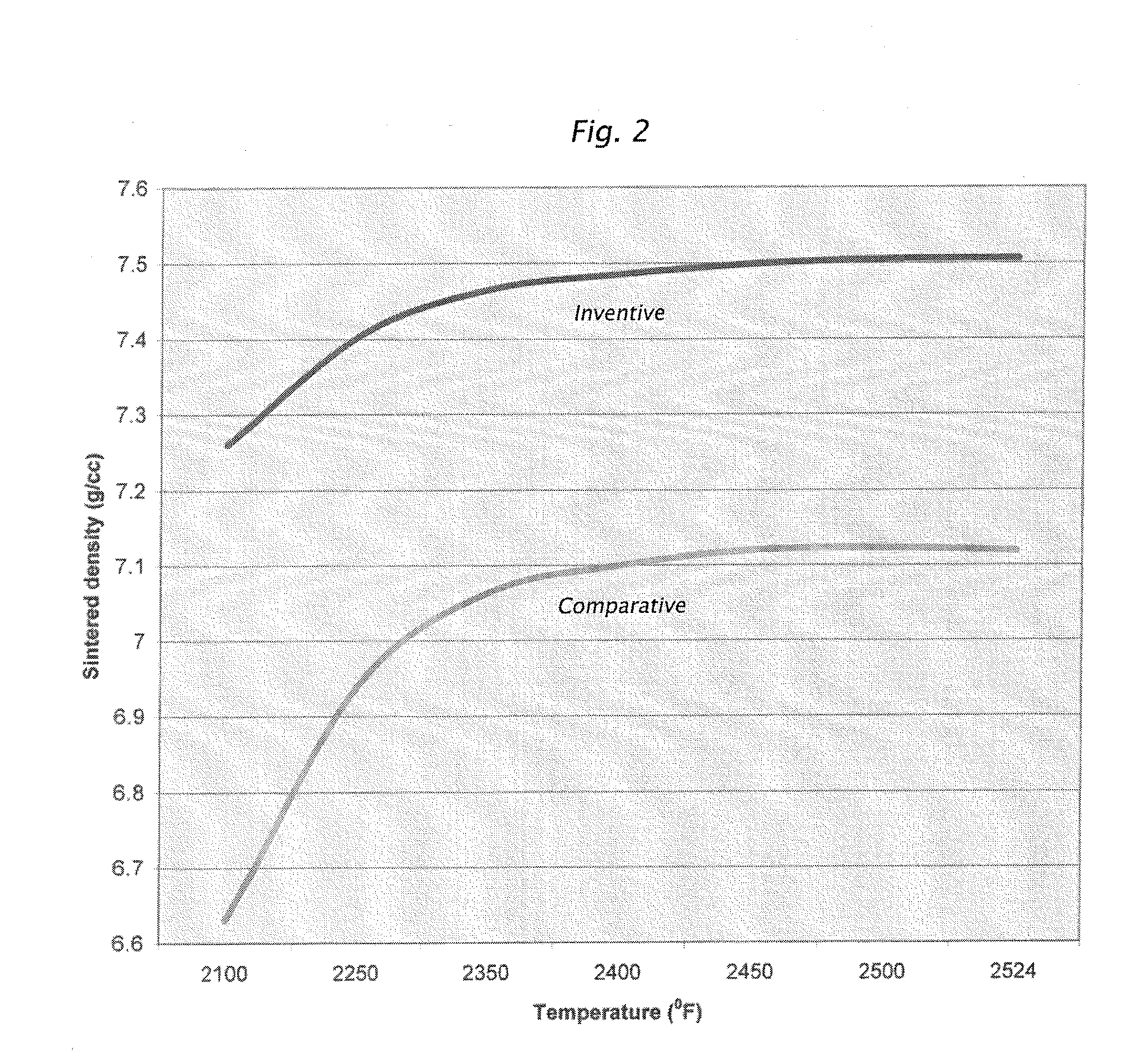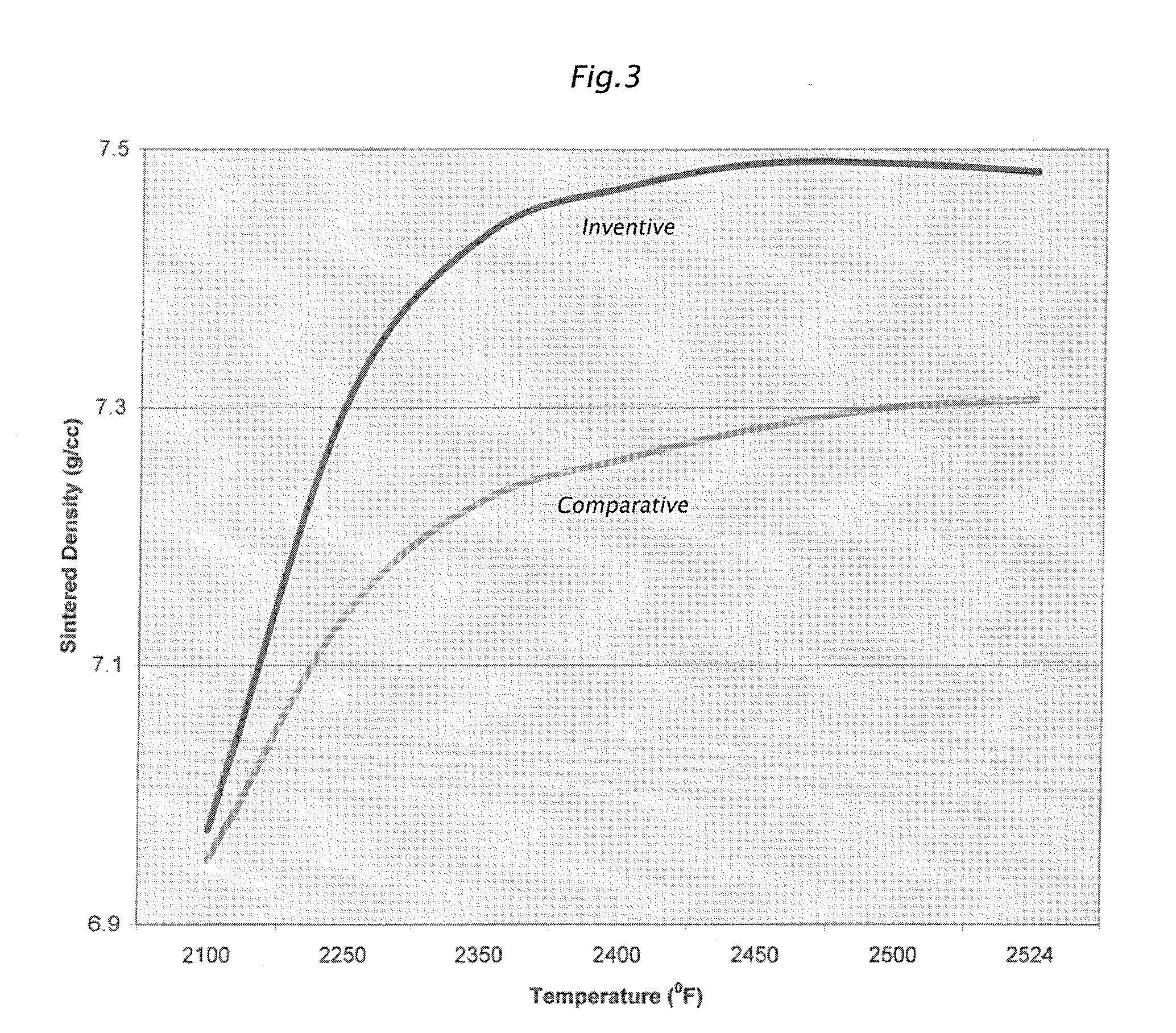Powder Metallurgy Methods And Compositions
a technology of powder metallurgy and compositions, applied in metal-working apparatuses, transportation and packaging, etc., can solve the problem that the sintered density of parts formed from most conventional metal powder compositions does not approach 100% of theoretical density, and achieve high sintered density, high densities, and high densities.
- Summary
- Abstract
- Description
- Claims
- Application Information
AI Technical Summary
Benefits of technology
Problems solved by technology
Method used
Image
Examples
example 1
[0055]A Stock Powder Metallurgy Composition (“Stock P / M”) was prepared by dry mixing the components set forth in Table 1 below:
TABLE 1ComponentWeight PercentANCORSTEEL 85 HP*97.00%UT-3PM**2.00%Graphite Powder0.65%SUPERLUBE PS1000-B***0.35%*ANCORSTEEL 85 HP is a water atomized, pre-alloyed steel powder (approximate chemical composition in weight percent: ~98.93% Fe; 0.86% Mo; 0.12% Mn; 0.08% O; and **UT-3PM is a high-purity nickel powder for pressed powder metallurgy applications available from Norilsk Nickel of Moscow, Russia.***SUPERLUBE PS1000-B is a pressed powder metallurgy lubricant capable of transforming from a solid to a liquid due to shear from Apex Advanced Technologies of Cleveland, Ohio.
example 2
[0056]Test bars were formed using the Stock P / M formed in Example 1. In Sample 1, the test bar was formed solely out of the Stock P / M formed in Example 1. In Samples 2 and 3, the test bars were formed by blending the Stock P / M with citric acid at a 0.2% by weight loading and a 0.4% by weight loading, respectively. Each test bar was formed using a 50 tsi (tons per square inch) Tinius Olsen hydraulic press. Each test bar had the following dimensions: ½″ wide×1¼″ long×¼″ thick.
[0057]The green density of the pressed test bars was measured in accordance with the procedures set forth in MPIF Standard 45 and ASTM B331-95 (2002). The green test bars were delubed at normal conditions and were sintered in a continuous furnace at a heat up rate of 133° F. / min in the hot zone to a temperature of 2,480° F. in an atmosphere consisting of 25% H2 and 75% N2. The density of the green and sintered test bars is reported in Table 2 below:
TABLE 2StockCitricGreenSinteredSampleP / MAcidDensityDensity1 100% ...
example 3
[0059]Test bars were formed using the same Stock P / M formed in Example 1 using the same procedures as set forth in Example 2. The green test bars were delubed at normal conditions, sintered in a continuous furnace at a heat up rate of 50° F. / min in the hot zone to a temperature of 2,480° F. in an atmosphere consisting of 25% H2 and 75% N2. The density of the green and sintered test bars is reported in Table 3 below:
TABLE 3StockCitricGreenSinteredSampleP / MAcidDensityDensity4 100% 0%7.29 g / cm37.42 g / cm3599.6%0.4%7.21 g / cm37.35 g / cm3699.2%0.8%7.10 g / cm37.23 g / cm3
[0060]The data reported in Table 3 shows that the presence of small amounts of citric acid in the Stock P / M blend does not result in any improvement in sintered density when the heat up rate is below 60° F. / min. Specifically, the sintered density of the test bars decreased with the addition of citric acid at a heat up rate of 50° F. / min due to lower green density to start. Typically there is a direct correlation between green ...
PUM
| Property | Measurement | Unit |
|---|---|---|
| molar weight ratio | aaaaa | aaaaa |
| molar weight ratio | aaaaa | aaaaa |
| particle size | aaaaa | aaaaa |
Abstract
Description
Claims
Application Information
 Login to View More
Login to View More - R&D
- Intellectual Property
- Life Sciences
- Materials
- Tech Scout
- Unparalleled Data Quality
- Higher Quality Content
- 60% Fewer Hallucinations
Browse by: Latest US Patents, China's latest patents, Technical Efficacy Thesaurus, Application Domain, Technology Topic, Popular Technical Reports.
© 2025 PatSnap. All rights reserved.Legal|Privacy policy|Modern Slavery Act Transparency Statement|Sitemap|About US| Contact US: help@patsnap.com



